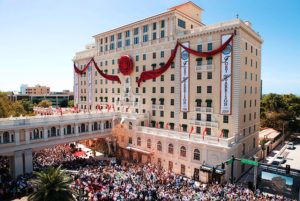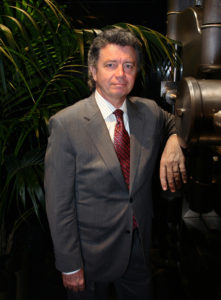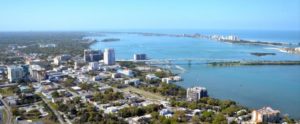After decades of largely-unsuccessful attempts to revitalize their downtown area–including streetscaping, sidewalk-widening, and a huge failed infill project–Clearwater, Florida is now taking the incentive approach. (Note from Storm: I lived in Clearwater and St. Petersburg for 15 years, so I’m quite intimate with the development history of Pinellas County in particular, and the Tampa Bay area in general.)
After long pursuing development along US 19 (the central north-south artery of Pinellas County), and along SR 60 (the major east-west artery of Clearwater), they finally want to make downtown the easiest and most profitable place to open a business in the city. They’d especially like to see more art galleries, microbreweries, and restaurants.
On June 12, 2017, the Clearwater Community Redevelopment Agency (CCRA) approved the Anchor Tenant Incentive Program to provide incentives of up to $250,000 each for both property owners and commercial tenants via a loan-to-grant program. The loans can be applied to business startup costs, such as rent, furniture, fixtures, and equipment, as well as for interior refurbishment.
The loans have 5-year terms. Here’s how the loan-to-grant portion works: for each year that the business stays open, 20% of the loan is forgiven. Thus, at the end of 5 years, the businesses will owe nothing if they’re still operating.
This is a strategy that has worked in some places. But it has also failed in many places when there weren’t enough downtown residents. All the up-front incentives in the world won’t keep a business alive in the long run if it doesn’t have enough customers. Incentives and subsidies can be considered the “artificial stimulant” approach to retail revitalization: it tends to go away when the “drugs” wear off. Resident-based retail revitalization, on the other hand, could be considered the “organic” approach to retail growth.
The wisest retail growth strategies thus focus first on downtown housing (especially affordable), and only then incentivize the businesses that will serve these residents. As pointed out in the new Resilience Strategy Guide, a resident can survive a lot longer without a nearby grocery store than a grocery store can survive without nearby customers. Residents have far more “revitalization patience”.
Fortunately, Seth Taylor, Director of Clearwater’s Community Redevelopment Agency, is aware of this danger. They are wisely focusing their strategy on attracting established local brand names that have a strong following in the Tampa Bay area, and will thus be less dependent on downtown residents.
In a June 16, 2017 phone conversation, Seth told me they aren’t overlooking the need to boost the downtown’s residential capacity. They already have over 400 units of new market-rate rental units under construction. This is especially good because rental units tend to be far more revitalizing than condos which–in resort areas like Clearwater–tend to be occupied only seasonally.
But wait, there’s more: Clearwater has long put its public administration offices on the waterfront (not to be confused with Clearwater Beach, which is on the other side of the beautiful Intercoastal Waterway). This was a rather self-serving decision on the part of city officials of decades past, since it boosted their quality of life at the expense of economic development. Public infrastructure–whether offices or sewer plants–are seldom the highest and best use of a good view.
Thus, the city’s new $55 million Imagine Clearwater master plan will move these office off the waterfront, freeing the valuable space for huge amounts of residential redevelopment. They’ll make even more room for residents by demolishing their failed waterfront convention center.
Our phone conversation took place only 5 days after the Anchor Tenant Incentive Program was announced, and Seth says they have already received 25 inquiries from Tampa Bay entrepreneurs.

Celebrating the restoration.of the Fort Harrison Hotel on March 14, 2009.
Photo credit: Church of Scientology.
Many local folks say that one of their most intransigent challenges is that the largest and most important downtown heritage building–the Fort Harrison Hotel, which opened in 1926–has for over 40 years been occupied by the highly controversial Church of Scientology. Their strong association with downtown Clearwater has, in some folks eyes, diminished its attraction as a business location.
Others point out that the Church of Scientology saved and restored a derelict building that might have otherwise have been demolished, and that Scientology staff and visitors have helped support downtown businesses. In addition, unlike most tax-exempt church activities, they currently pay over $205,000 annually in property taxes on the hotel.
In a June 26, 2017 letter to REVITALIZATION, Church of Scientology Director of External Affairs Ben Shaw said: “over 12,000 Scientologists now live in the greater Clearwater area, fully 10% of the Clearwater population. …a 2013 report by economists at Florida State University (said that) the Church and its related activities had a $917 million annual positive impact on the local community. The Church has seen even further expansion in Clearwater since that study was published in 2013, and the figure is now well over $1 billion. …In total, the Church’s contribution to the beautification and redevelopment of downtown would have exceeded $65 million by the end of 2017.”
Either way, the church/city relationship has been controversial from the very beginning. The Church of Scientology secretly acquired the dilapidated Fort Harrison Hotel property in 1975, purchasing it under the false names “Southern Land Development and Leasing Corp” and “United Churches of Florida Inc.“.
In 1976, the Church of Scientology’s connection with the names on the purchase was reported by the St. Petersburg Times, as was their plan for a $2.8 million restoration and upgrade of the hotel.
I wish Clearwater all the best, as I love the city, and the Tampa Bay area in general. This downtown revitalization has been a long time coming.
About the Author:
 Storm Cunningham is the publisher of REVITALIZATION, an author, and a consultant on resilient economic growth.
Storm Cunningham is the publisher of REVITALIZATION, an author, and a consultant on resilient economic growth.
His 100+ global client list includes: US State Department, Boeing, Harvard University, Ontario Chamber of Commerce, Israel Planners Association, European Property Italian Conference, University of Guadalajara, National Arbor Day Foundation, U.S. Environmental Protection Agency, American Institute of Architects, Project Management Institute, US Embassy (Poland), Governor of Montana, Canadian Urban Institute, Santee Cooper, Urban Land Institute, University of Texas, Leadership Cleveland, and many more.
A former Green Beret SCUBA Medic, Storm lives in Arlington, Virginia, and is the author of two highly-acclaimed books: The Restoration Economy (Berrett-Koehler, 2002), and Rewealth (McGraw-Hill Professional, 2008). His upcoming 3rd book is RECONOMICS (coming January 2020).


